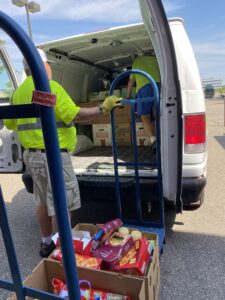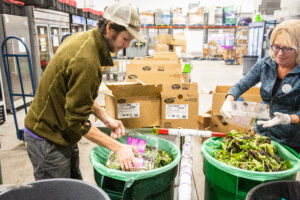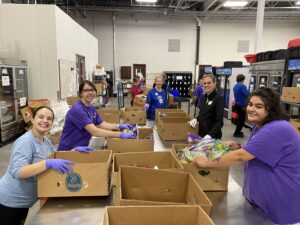The Open Door provides food to roughly 14,000 people every month, but where does all the food come from that gets distributed to families across Dakota County?
 Three main sources make up The Open Door’s food inventory and the nearly 3 million pounds of food that gets distributed annually: purchased food, donated food and rescued food. The first two sources are very straightforward. The Open Door purchases food from partner food banks like Second Harvest Heartland and takes in donated food via community food drives, a Giving Gardener program, and more – but what exactly is rescued food?
Three main sources make up The Open Door’s food inventory and the nearly 3 million pounds of food that gets distributed annually: purchased food, donated food and rescued food. The first two sources are very straightforward. The Open Door purchases food from partner food banks like Second Harvest Heartland and takes in donated food via community food drives, a Giving Gardener program, and more – but what exactly is rescued food?
Is The Open Door flying around with a cape rescuing viable food from going into landfills? Well, kind of. Lose the cape, replace flying with driving, throw in roughly 40 volunteers each weekday plus 10 partner grocery stores, and you’ve got a pretty clear picture of The Open Door’s food rescue operations.
The Open Door rescues roughly 25,000 pounds of food every week from partner grocery stores. In the first six months of 2023, 626,346 pounds of food was rescued. The food that Open Door volunteers rescue every weekday morning is what grocery stores would otherwise throw away to make room for their new inventory or food that’s maybe not selling as well. It’s fresh produce. It’s meat. It’s dairy, bread, and shelf-stable items like canned goods and pasta. It’s food that hasn’t passed its actual expiration date and can still be eaten, enjoyed even. 
The Open Door’s food rescue operations were recently featured in a WCCO news story on food waste in Minnesota, highlighting how 62% of food thrown out by Minnesotans could be eaten or at least donated. The story also mentions a recent finding from the Minnesota Pollution Control Agency (MPCA), that the Twin Cities generate almost 3.3 million tons of waste each year, up by more than 30% in just one year. The MPCA’s findings confirmed that food waste is a huge problem that requires all of us to evaluate our own habits.
The Open Door established a solution to not only rescue viable food from ending up in landfills but to distribute it to Minnesotans in need. To add an extra, sustainable element to these food rescue operations, any food items that end up being unsuitable for distribution are composted.
It takes many extra steps, hours, and volunteers to keep food rescue operations running at The Open Door, but the multilayered benefits make it all worth it. It is a whole systems approach that not only benefits the planet but benefits the 14,000 people who turn to The Open Door for food every month. 
From driving Open Door vans to pick up food, sorting the food back at the warehouse, and prepping food for distribution, there are roughly 40 volunteers needed every weekday for food rescue operations. With these volunteer roles averaging two hours each, it’s a quick and easy way to get involved in curbing food waste AND helping people in need of food support. To learn more and get started, head to theopendoorpantry.org/get-involved/volunteer or reach out to The Open Door’s Volunteer Coordinator, Veronica, at veronica@theopendoorpantry.org. Read the full WCCO article HERE.
Leave a Reply